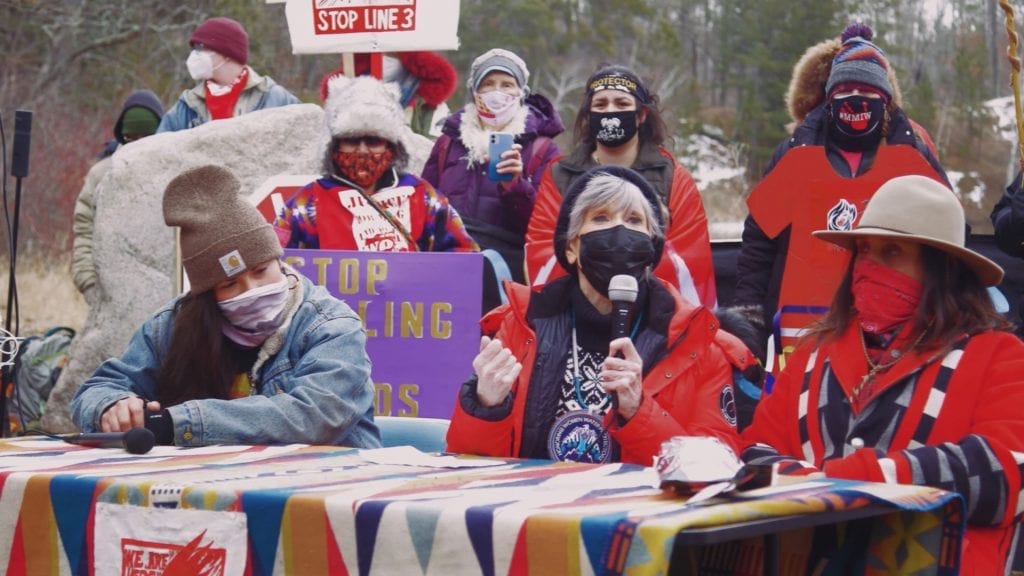
Activist and actress Jane Fonda, centre, speaks at a recent Line 3 protest in the United States. The pipeline project runs from Canada to Lake Superior in Wisconsin. Photo: Keri Pickett
It’s a pipeline that stretches across three provinces from Alberta to Manitoba before entering the United States.
The Enbridge Line 3 pipeline is going to carry tar sands bitumen and the project has gone on with little opposition in Canada.
That’s not the case in the United States.
After the pipeline leaves Manitoba, it ends up at the mouth of Lake Superior in Wisconsin.
There’s been Native American-led protests regularly over the last several years, including recently with actress Jane Fonda.
But despite the protests, Enbridge has been able to avoid another brutal clash that was seen at Standing Rock over the Dakota Access Pipeline a couple years ago.
According to Mary Annette Pember, a national correspondent with Indian Country Today, that’s because Enbridge has used its deep pockets and clever messaging.
“What they’ve done is pretty effectively divided the community, they’ve offered a whole lot of money and some tribes have accepted,” said Pember on Nation to Nation.
Pember recently wrote about how Line 3 has divided Indigenous lands and people.
Also on N2N, Indigenous Services Minister Marc Miller discusses the federal budget, the Grand River land dispute in southern Ontario and racism in his department.
Two thirds of this year’s proposed $18-billion Indigenous spend would go toward health care and shovel-ready infrastructure projects like water treatment facilities, roads and housing.
But — while the Ottawa money faucet is pouring freely right now — increasing expenditures by 300 per cent every two years simply isn’t sustainable.
So what’s the long-term plan?
“The mandate of my department is to get itself out of existence, but that requires closing the socioeconomic gaps that are so large between Indigenous and non-Indigenous communities,” replied Miller. “They lie in health care, infrastructure and education.”
The minister explained this requires economic development, increasing own-source revenue and, at some point, “having difficult discussions around land.”
To do that, he could head a few hours down the highway to Caledonia, Ont. where these issues are playing out in real time.
Earlier this week, customary chiefs of the Haudenosaunee Confederacy demanded a halt to property development across the entire Grand River watershed.
The million-acre parcel is known as the Haldimand Tract and was granted to the Haudenosaunee in 1784.
The feds have been accused of failing to resolve land claims, refusing to negotiate and allowing the situation there to spiral into civil unrest.
Miller disagreed, saying Ottawa has made overtures to the traditional leaders and remains willing to meet.
“We do speak. We do communicate views. But so far, an official invitation from the Confederacy in Six Nations has not been extended — for a variety of reasons that we respect,” said Miller. “When we are properly invited, Minister (Carolyn) Bennett and I will attend.”
Back to the budget, notably missing is money to settle with victims of Canada’s discriminatory child welfare system on reserves and in the Yukon.
Ottawa pledged to pay these kids, many of them now adults, in winter of 2019. The budget office predicts it could cost $15 billion, yet the spending plan sets a mere $3 million aside for resolving Indigenous childhood claims.
That cash doesn’t need to be in the budget, said Miller, adding if a settlement is struck the funds will flow.
“The prime minister has said quite clearly, and he continues to say it, that we recognize that discrimination has occurred,” he said, “and we will compensate the victims as well as effect systemic change.”
Finally, two weeks ago, N2N examined systemic racism within Indigenous Services and Crown-Indigenous Relations.
Miller said the departments’ top bureaucrats are reviewing the issue but shared few details about what that review will look like.
“This is something that exists across ministries but it is particularly poignant in these departments that are fraught with all the historical weight that Indigenous Service Canada and Crown-Indigenous Relations Canada carry in the eyes of many,” he said. “I’m mindful of that: It is entirely unacceptable.”
Watch the full episode below.











